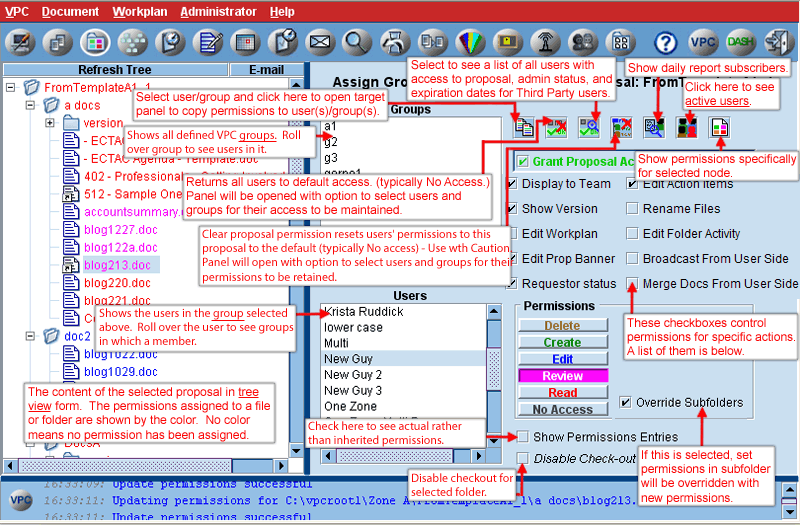To assign permissions for this proposal to specific users or groups,
first select the group or user from the list, then the folder, file or link from the treeview, then select the permission type from the Permissions list. Permission can be set on folder links, but any permission above read only will be interpreted as read only. Folder links inherit permissions, just like regular folders. When the users panel is selected and you hit a letter key, the list will scroll to the user name beginning with that letter. Use the Shift key for continuous selection of users/groups/folders/files. Use the Ctrl key for multiple individual selections of users/groups/folders/files. Use Ctrl -A key to select all users or all groups.
The color
of the folder in the treeview and the button will change to match the color of the permission in the
list, indicating that the specified permission has been assigned for that
folder, file or link to that user or group. Select a node and user(s)/group(s) and click on applicable, colored, activated permission button to clear permissions specifically set on that node for selected user(s)/group(s). To copy permissions from one node to another node, right click on the source node and select Copy Permissions. Right click on the target node and select the now-activated Paste Permissions. This will only copy permissions specifically set on the node and will not override subfolder permissions.
The icons on the top right give the ability to:
- copy permissions from a user or group to other users and/or groups. Select user or group, click on copy permissions icon, and then select the targets from the panel that opens. Can also choose to copy proposal rights (e.g., Display to Team, Edit Workplan, etc.) to the target user. Only users who have been designated as
"Available" in that zone will show in the Users box.
- clear proposal access for selected users and groups.
- show users with proposal access along with users' admin status and expiration date for third party users. Admins that are blocked from the proposal will still show as an admin but will be displayed with an "*" in the admin column.
- clear permissions explicitly set for selected users and groups. Can also clear group-based permissions for selected users.
- show the daily report subscribers.
- show the active users along with their highest permission level.
- show all permissions explicitly set for a single node.
To temporarily disable check-out for edit or review for all users without changing their permission settings, select a folder in tree view, and then click on Disable Check-out. This works like permissions in that check-out disable is inherited from top-level folders. Folders/files that have check-out disabled will show in italics in permissions tree view. The check box will turn blue if the selected folder/file has check-out disabled, but it is inherited from higher-level folder. If a folder selected for disable check-out has a file within it that is checked out for edit, a warning panel will appear with an option to cancel action.
You can modify various settings for a particular user or group. Display to Team determines whether a user or group is displayed in the Team Member list on the user side. Edit Action Items can allow a user or group to fully edit, add, delete, and export action items on the user side. Rename Files allows a user or group to edit file names on the user side given they also have create permission. They can only rename files from the Add Document to VPC screen. Select user or group and uncheck Show Version if you do not want a user or group to see version folders for that specific proposal. Edit Workplan can allow a user to edit the workplan with full capabilities on the user side. Edit Folder Activity allows a user to set a document's status in the Folder Activity Report on the user side. Edit Prop Banner allows a user to edit the Proposal Banner on the user side. Broadcast From User Side allows a user to send broadcast messages from the user side, though Send Proposal Welcome is not enabled. Requestor Status allows a user to generate requests to add users to the proposal, to change group membership for users in the proposal and other miscellaneous things.
|
